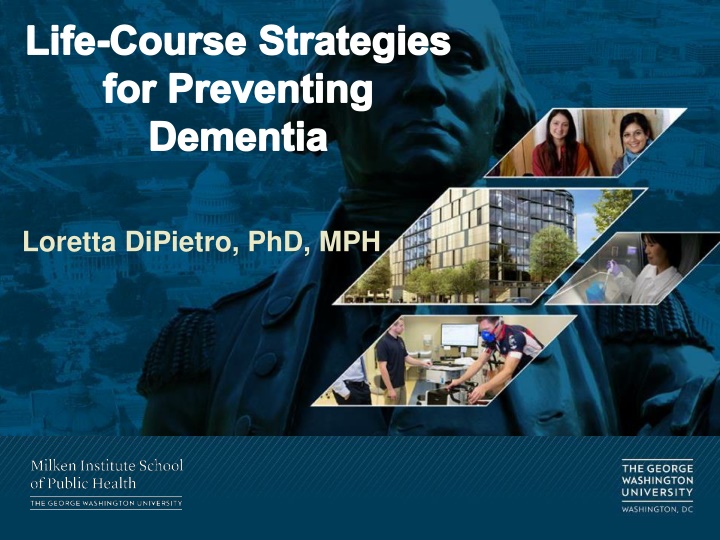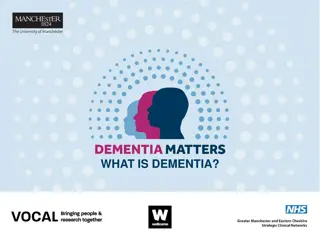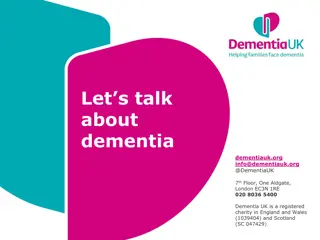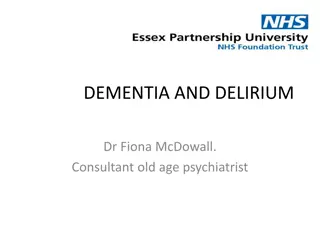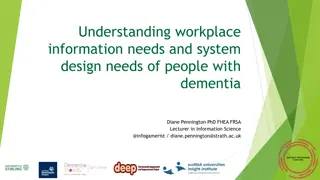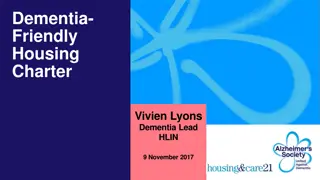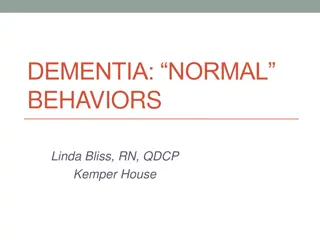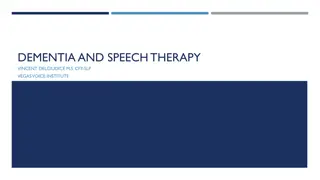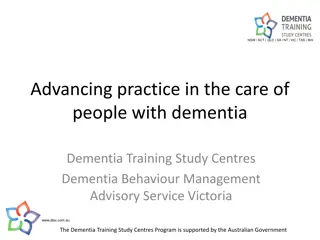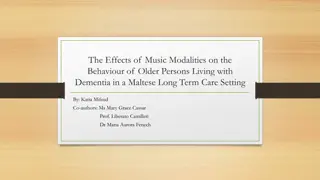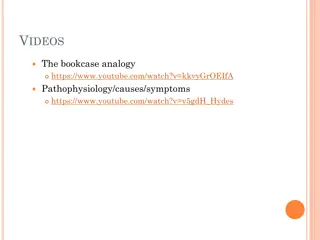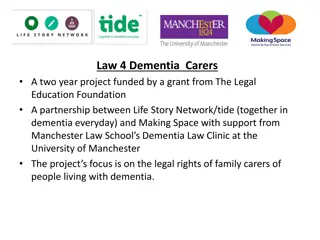Strategies for Preventing Dementia: A Comprehensive Overview
Dementia is a complex and multifactorial disease with significant societal and economic impacts. This comprehensive overview discusses the prevalence of dementia, modifiable risk factors, and preventive pathways across the life course. By addressing factors such as education, physical activity, and cardiovascular health, it emphasizes the importance of early intervention and lifelong strategies to reduce the burden of dementia.
Download Presentation

Please find below an Image/Link to download the presentation.
The content on the website is provided AS IS for your information and personal use only. It may not be sold, licensed, or shared on other websites without obtaining consent from the author.If you encounter any issues during the download, it is possible that the publisher has removed the file from their server.
You are allowed to download the files provided on this website for personal or commercial use, subject to the condition that they are used lawfully. All files are the property of their respective owners.
The content on the website is provided AS IS for your information and personal use only. It may not be sold, licensed, or shared on other websites without obtaining consent from the author.
E N D
Presentation Transcript
Life-Course Strategies for Preventing Dementia Loretta DiPietro, PhD, MPH
Background Approximately 11.2% of Americans over age 65 have probable dementia and 10.6% have possible dementia according to the National Health and Aging Trends Study; These estimates are expected to increase by 2050 and have significant implications for the health and function of older adults, as well as for their families, and the healthcare system; Dementia significantly impairs daily functioning, with estimated costs in the United States of between $159 and $215 billion each year;
Dementia is a multifactorial disease As much as 40% of dementia may be attributable to twelve modifiable risk factors: low education physical inactivity obesity in mid-life depression social isolation traumatic brain injury air pollution current smoking hypertension diabetes hearing loss excessive alcohol use Lancet Commission, 2020
A Life Course Approach to Preventing Dementia Early Life Mid-Life Later Life Lancet Commission, 2020
Population attributable fractions for 12 dementia risk factors Lancet Commission, 2020
Preventive Pathways Preventing neuropathological damage; Increasing and maintaining cognitive reserve
Dysregulation of metabolic, inflammatory, and oxidative pathways Later- Life Mid- Life Early Life Cardiovascular dysregulation Inflammation Endothelial dysfunction Arterial stiffness Low vascular reactivity Increased AGE Increased homocysteine Mitochondrial toxicity Neuropathology Brain blood flow Brain volume Hyperphos tau -amyloid40,42 Cognitive Decline Obesity Hyperglycemia Hyperinsulinemia Physical inactivity Obesity Hypertension Diabetes Smoking Alcohol
Lifes Simple 7 Smoking Diet Physical activity BMI Fasting glucose Cholesterol SBP/DBP AHA, 2010
Association of ideal cardiovascular health at age 50 with incidence of dementia: 25 year follow-up of Whitehall II cohort study (N=7,899) HR= 0.89 (95% CI: 0.85 to 0.95) Sabia S, et al. BMJ 2019;366:l4414
Building and Maintaining Cognitive Reserve Social isolation Air pollution Racism Sexism Poverty Hearing loss Low education Traumatic Brain Injury Depression Excessive alcohol use
Cognitive Reserve Educational attainment; Occupational complexity; Later-life engagement in cognitive-intellectual activities.
Association of Daily Intellectual Activities With Lower Risk of Incident Dementia Among Older Chinese Adults (N=15,582) Prospective study of community-dwelling older adults ( 65 y) living in China; Median follow-up time was 5 years; Late-life intellectual activities included reading books, newspapers, or magazines; playing board games, Mahjong, or card games; and betting on horse racing. ATC Lee, et al. JAMA Psychiatry 2018
Estimated ORs for Incident Dementia After Excluding Participants Who Developed Incident Dementia Within 3 Years After Baseline (N=15,582) Model 2a Type of Leisure Activities Model 1 OR (95% CI) P Value OR (95% CI) P Value Intellectual 0.59 (0.50- 0.68) <.001 0.71 (0.60- 0.84) <.001 Social 1.00 (0.83- 1.19) .96 0.97 (0.81- 1.17) .78 Other recreational 1.50 (0.84- 2.69) .18 1.56 (0.86- 2.81) .14 a Adjusted for age, sex, educational level, cardiovascular risk factors, visual and hearing impairments, poor mobility, depression, smoking, adequate consumption of fruits and vegetables, regular physical exercise, and other types of leisure activities. ATC Lee, et al. JAMA Psychiatry 2018
Education Intellectual capacity gains due to education tend to plateau in late adolescence; Reverse causation those people with higher intellectual capacity tend to attain more education, achieve higher occupational status, and engage more in cognitive-intellectual activities. Kremen WS, et al. PNAS. 2019;116:2021-2026
Vietnam Era Twin Study of Aging (VETSA) (N=1009 male veterans) *GCA measured at age 20 and age 62 by the Armed Forces Qualification Test (AFQT) Kremen WS, et al. PNAS. 2019;116:2021-2026
Traumatic Brain Injury Mild TBI Concussion Severe TBI Skull fracture Edema Brain injury Bleed Hyperphosphorylated tau pathology
Relative risk of all-cause dementia associated with mid-life TBI Lancet Commission, 2020
Table 2. Associations between TBI and the risk of dementia during follow-up in 491,252 Swedish citizens >50 years. Nordstr m A, Nordstr m P (2018) Traumatic brain injury and the risk of dementia diagnosis: A nationwide cohort study. PLOS Medicine 15(1): e1002496. https://doi.org/10.1371/journal.pmed.1002496 https://journals.plos.org/plosmedicine/article?id=10.1371/journal.pmed.1002496
Dose Response Association between TBI and Dementia Risk Odds Ratio 3 2.5 2 1.5 1 0.5 0 Mild Severe Multiple Traumatic Brain Injuries Nordstr m A, Nordstr m P (2018)
N=357,558 Military Veterans Barns DE, et al. 2018
Exposure to ambient air pollution and the incidence of dementia: A population-based cohort study* PAF=6.1% wPAF=2.3% *A 12-y prospective study of over 2 million Canadian-born adults 55-85 y Chen H, et al. Environment International. 2017
Burden of Dementia-Specific Mortality Associated With PM2.5 Air Pollution in the United States Age- standardized Rate/100,000 PAF Total Deaths Rate/100,000 Dementia Mortality 8.2 (6.0-13.1) 19,852 6.1 5.1 A cohort of 4,522,160 US veterans followed up between 2006 and 2016. The burden was particularly high in African Americans and those living in low socioeconomic communities. Bowe B, et al. JAMA Network Open, 2019
Air Pollution and Dementia: a Systematic Review Peters R. et al., J Alzheimer s Disease. 2019
Social Isolation Social Isolation 25% of older adults live alone; 20% of older adults report feeling lonely; Social isolation among older people is associated with an extra $6.7 billion in Medicare spending per year Meals on Wheels America, 2020
Influence of social relationship domains and their combinations on incident dementia: a prospective cohort study (N=13,984)* *13,984 community-dwelling Japanese older adults followed for 9.4 years. Saito T, et al. J Epidemiol Community Health, 2018
Influence of social relationship domains and their combinations on incident dementia: a prospective cohort study (N=13,984) Saito T, et al., 2018
Preventive strategies targeted toward the Preventive strategies targeted toward the individual individual Lancet Commission, 2020
Policy, Systems, Environment (PSE) Approach Working at a more foundational level to address causes and improve environments where we live, work, learn, play, and receive health care, we can prevent many people from becoming chronically ill Can help public health advocates create sustainable, comprehensive measures to improve public health Policy Systems Environment Written statement of organizational position, decision or course of action. (such as ordinances, resolutions, mandates, guidelines, or rules) Changes in organizational procedures (such as personnel, resource allocation, programs) Physical, observable changes in the built, economic, and/or social environment.
PSE Priorities Prioritize education across the life-span; Create healthy food and built environments; Create stricter laws to reduce sport-, occupational-, and transportation-related TBIs; Create stricter air pollution regulations especially in low- income neighborhoods; Create stricter occupational and environmental noise pollution regulations; Strengthen national efforts to reduce exposure to SHS especially among children; Create more Age-Friendly environments Adapted from Lancet Commission, 2020
